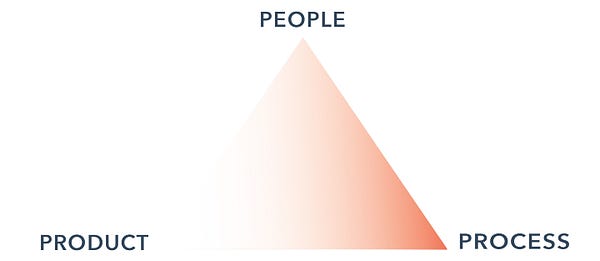leadingIn(tech)#15: Eliminate toil and give way to the team
September 2022
September 2022
Hi there! 👋🏽
Welcome to a new issue of leadingIn.tech newsletter. I'm Roberto, and this is where I share ideas, practices, and learnings towards becoming a better leader in technology.
Photo by Will H McMahan on Unsplash
Last week I crossed with the post Why our engineering leaders focus on product over process where it talks about how HubSpot changed what they considered the primary role of an engineering leader assuming that you can only focus as much as on two out of the three main areas of influence for an engineering leader: people, product or process. By the time the article was written the company decided to move from People and Process to focus on the People and Product areas.
After reading that post my first reaction was to ask myself, why do they need to choose at the company level? And I believe they don't have to. On this issue, I’ll try to expand a bit more on my thoughts beyond the first reaction.



💡 learnings and ideas to become 1% percent better every day
In one of the first issues of this newsletter, I asked myself the question “What does an Engineering Manager do anyway?” at the time I divided it into People, Delivery, Engineering, and Product with a few extra balls. But the main aspect of it is that I believe that depending on the context of the organization or the team the amount of time dedicated to any of these areas will vary. So the role of the Engineering Leader can be also described as eliminating toil and giving way to the team to do the work.
Eliminate Toil
By using as inspiration the concept of eliminating toil from the Google - Site Reliability Engineering book. Let's explore what is toil, with slight modifications.
Toil is the kind of work tied to running a production service that tends to be manual, repetitive, automatable, tactical, devoid of enduring value, and that scales linearly as a service grows.
By reading this we can understand that an engineering leader’s job is to help to eliminate any repetitive and non-value-adding work, so if we go back to the People-Product-Process triangle we can imagine that removing unnecessary processes that do not help the team to create value will be toil that will slow them down. Meaning that your job as an engineering leader is to help them identify what needs to be moved off their plate, automated or delegated.
Are your “agile” processes getting in the way? Then help them iterate over it and streamline it
Are they spending too much time generating status reports for the leadership? Find ways to automate it or to make the report as light way as possible
Are they spending too much time on fixing production issues or dealing with support requests? Help them identify the root causes, reduce technical debt, or enable other parts of the organization to manage support (e.g: training, documentation, etc.)
Clear the way for your team. So they can focus on solving the problems that need to be solved.
Give Way
Here again, I’ll use another inspiration this time from a post titled “Always be leaving” from my friend Angel which was at the same time inspired by the same quote from Bharat Mediratta in the book Software Engineering at Google
So you have helped your team to eliminate their toil? What now?
I would recommend now giving way to the team to operate autonomously. Take a step back and observe, and find what is the next area where you can add the most value to help them operate at their best. Is it by working on the individual's growth? Or is it by partnering with the product managers to find what is the next biggest problem you need to solve for your customers?
The important thing here is that you remove yourself from the way so you are not necessary for the team to operate as you were about to leave.

As an Engineering Leader, you are responsible for the systems composed of the People, the Products, and the Processes. And your focus should be the one that helps to keep the harmony between them.
🎧Related Issues
leadingIn(tech)#2: “What does an Engineering Manager do anyway?”
📄Related Articles
Why our engineering leaders focus on product over process
Always be leaving by Ángel Cereijo
📚 Related Books
Google - Site Reliability Engineering




